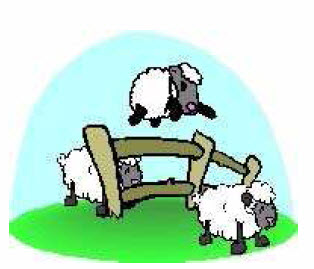things, I decided to try it out. The only problem was, there were no sheep around to be counted when I went to bed.

Creative as I am, that wasn't going to stop me. I sat down and wrote a computer program that made a grid of characters, where # represents a sheep, while . is grass (or whatever you like, just not sheep). To make the counting a little more interesting, I also
decided I wanted to count flocks of sheep instead of single sheep. Two sheep are in the same flock if they share a common side (up, down, right or left). Also, if sheep A is in the same flock as sheep B, and sheep B is in the same flock as sheep C, then sheeps
A and C are in the same flock.
Now, I've got a new problem. Though counting these sheep actually helps me fall asleep, I find that it is extremely boring. To solve this, I've decided I need another computer program that does the counting for me. Then I'll be able to just start both these
programs before I go to bed, and I'll sleep tight until the morning without any disturbances. I need you to write this program for me.
Each test case begins with a line containing two numbers, H and W, the height and width of the sheep grid. Then follows H lines, each containing W characters (either # or .), describing that part of the grid.
Notes and Constraints
0 < T <= 100
0 < H,W <= 100
2 4 4 #.#. .#.# #.## .#.# 3 5 ###.# ..#.. #.###
6 3
前几天用DFS做了一次
现在用BFS再做一次
原理就是已找到#就+1,然后把#附件连通的#全部变成“.”
#include <stdio.h>
#include <string.h>
char map[105][105];
int to[4][2] = {1,0,-1,0,0,1,0,-1};
int n,m,cnt;
void bfs(int x,int y)
{
int i;
int xx,yy;
for(i = 0;i<4;i++)
{
xx = x+to[i][0];
yy = y+to[i][1];
if(xx<0 || yy<0 || xx>=n || yy>=m || map[xx][yy]!='#')
continue;
map[xx][yy] = '.';
bfs(xx,yy);
}
}
int main()
{
int t;
scanf("%d",&t);
while(t--)
{
scanf("%d%d",&n,&m);
int i,j,l;
cnt = 0;
for(i = 0;i<n;i++)
{
scanf("%s",map[i]);
}
for(i = 0;i<n;i++)
{
for(j = 0;j<m;j++)
{
if(map[i][j] == '#')
{
cnt++;
map[i][j] = '.';
bfs(i,j);
}
}
}
printf("%d\n",cnt);
}
return 0;
}